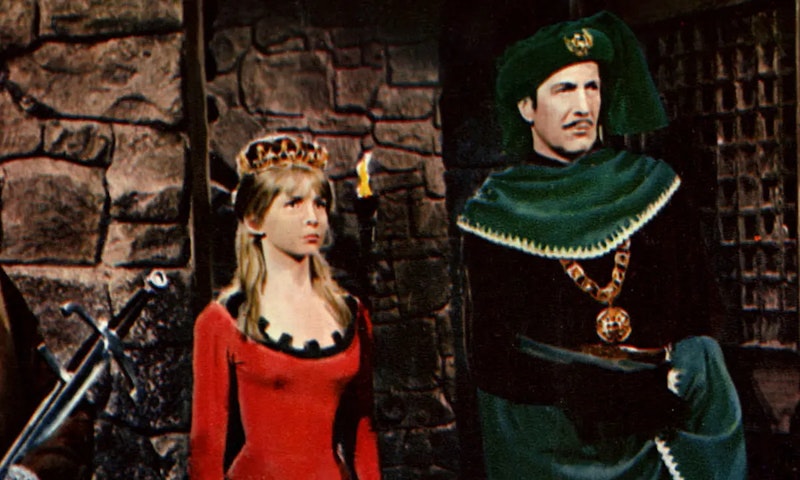After the success of Roger Corman’s film adaptation of “The Fall of the House of Usher” in 1960, he was given the chance to direct another Poe story. He felt “The Pit and the Pendulum” and “The Masque of the Red Death” were the two logical possibilities but thought “Masque” was too reminiscent of Bergman’s The Seventh Seal and so adapted “Pit.” And then more stories after that. As he tells it, “After each one did well, they asked me to do another. I’d give them two choices, and each time, one would be ‘Masque of the Red Death,’ but we kept staying away from it until late in the cycle. Finally, I had run out of what I thought were the best Edgar Allan Poe stories, so I said, ‘I don’t care if they think I’m copying Ingmar Bergman; I’m going back to ‘Masque of the Red Death,’ because I think that and ‘Usher’ are really his two greatest stories.”
First announced in 1961, after House of Usher, Corman filmed five other Poe (or Poe-related) adaptations before The Masque of the Red Death finally came out in 1964. He’d gone through a number of screenplays by that time trying to find the key to the story, including a version by a young writer named Robert Towne (still a decade away from Chinatown). Eventually he used a script by Charles Beaumont and R. Wright Campbell. It’d end up one of the most spectacular of Corman’s Poe films, but not entirely because of the script.
On its own, the script is good: as the plague called the Red Death sweeps Renaissance Italy, the tyrannical Satanist Prince Prospero imprisons a beautiful village girl, Francesca (Jane Asher), in his castle and prepares a carnival for his noble allies. Prospero’s mistress Juliana (Hazel Court) hates the innocent Francesca, but Prospero’s determined to convert her to the service of Satan. Over the course of the film he explains his philosophy of power as Juliana seeks greater intimacy with Satan himself. But can the Red Death be thwarted for long?
The story works, and Price is gripping, apparently enjoying the chance to play an outright wicked man who has a detailed intellectual basis for his evil. But it’s the visuals that elevate this film, giving it a richness and texture unlike Corman’s previous Poe adaptations.
Corman’s backers at AIP made a deal with the English studio Anglo-American Productions, and Corman got to use Anglo-American’s British facilities for his films. The first immediate practical result for Corman was that he now had access to a larger collection of sets and props than in previous movies; Masque was filmed on sets left over from Beckett, which had almost 10 times Masque’s budget.
He also had access to an English crew, which paid dividends in his choice of cinematographer: a young Nicolas Roeg. Roeg and Corman created a film with striking visuals based around the conceit from Poe’s story about a series of rooms wholly dedicated to a specific color. What the visual artists understood was that when doors were opened you’d see one room while standing in another. The different colors sometimes dominate the screen one by one, and at other times make layers to the composition that contrast with each other. It’s a striking effect, often beautiful and thoroughly cinematic.
As rooms open into other rooms, so narratively the characters open to other characters and intersect with them in unexpected ways. Each has their own arc, their own development as an individual. Beyond the Prospero-Francesca-Juliana triangle (or quadrangle if you include the unseen Satan), there’s also a subplot borrowed from Poe’s story of “Hop-Frog” involving Prospero’s court jester seeking revenge on a callous aristocrat, and this intersects nicely with the main plot, extending it and balancing it so that Prospero’s evil has some meaningful contrast.
That’s important given the power of Price’s portrayal. He’s beyond sinister in this film, laying out Prospero’s justification for wickedness with a mix of glee and matter-of-factness: “If a god of love and life ever did exist... he is long since dead. Someone... something, rules in his place.” For Prospero, Satan’s a God of reality, and of the truth of the evil of the world.
Despite Prospero’s wickedness the atmosphere of the film is richer than the other Poe films; more eerie and uncanny. There’s a sense that more’s going on than any one character understands. Prospero and Juliana are aware that there’s more to be learned or experienced; both want to be more evil than they are, to rise higher in Satan’s eyes. Much as they claim to worship power, their hope for the future is to be slaves to Satan. That means there’s an unstated nihilism in the movie, which comes out at the conclusion in a way faithful to Poe. The point of the original story, its decadence and its bleakness, is developed with a creative character-based structure appropriate to the horror genre.
The Masque of the Red Death is the height of Corman’s Poe films, the most visually powerful and the most fully realized world. You can see Corman’s usual fascinations here—including a mention of the Inquisition in Prospero’s family tree—and you can see echoes of its time in the way the story develops. Prospero’s lke an early version of Charles Manson, a charismatic leader with a depraved cult. Corman has spoken about the film as reflecting a countercultural view of the rich elites isolated by their own power, and it’s tempting to see Prospero as an anticipation of the hubris of today’s billionaires: men seeking to become God. He’s definitely the most articulate speaker for evil in Corman’s Poe films. But also the one who receives the most memorable come-uppance.

